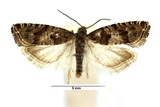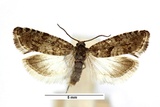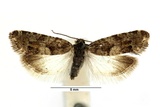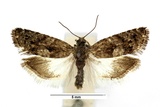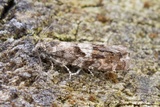Epinotia pygmaeana (Hübner, [1799]) Species
Last modified: Oct. 14, 2025, 3:31 p.m.
A very rare species in Belgium.
Details
- Classification
- Family: Tortricidae > Subfamily: Olethreutinae > Tribus: Eucosmini > Genus: Epinotia > Species: Epinotia pygmaeana
- Vernacular names
- Witvleugeloogbladroller (NL), Dingy Spruce Bell, Dingy Spruce Tortrix (EN), Kleiner Fichtennadelmarkwickler (DE)
- First mention in Belgium
- De Sélys-Longchamps E. 1844. Énumération des insectes Lépidoptères de la Belgique. — Mémoires de la Société royale des Sciences de Liége 2: 1–35. On page 21.
- Status
-
Native
Distribution
Imago
Wingspan 12–14 mm. In the genus Epinotia the only species whose males have combed (double-bristled) antennae. It has a dark marked basal patch on the forewing, the dorsal patch may be pale and may be contiguous with the costal half of the wing post basal patch. It has a noticeable whitish patch on the inner area of the hindwing.
Caterpillar
Body light green, head light brown or black, nape greenish or yellowish, also dark brown, sometimes with an indistinct dark spot on the side, the anal valve is poorly distinguished.
Bionomics
Groups of young needles are completely mined out by the young larvae. Between the needles only a few strands of silk (often also bud scales are trapped in the silk). Later in summer the larva lives free among spun needles. Pupates in the ground litter in a white cocoon to emerge the following year.
The adults are active in late afternoon and later come to light.
Flight periods
The adults heve been seen from mid-March till early June.
Observed on
- Host plant (species):
- Abies alba
- Host plant (genera):
- Picea
The larva livs on Picea abies and on Picea sitchensis. Perhaps but not sure possibly on Abies alba.
Habitat
it inhabits coniferous woodland, mixed forests, plantations and sometimes isolated spruce trees.
